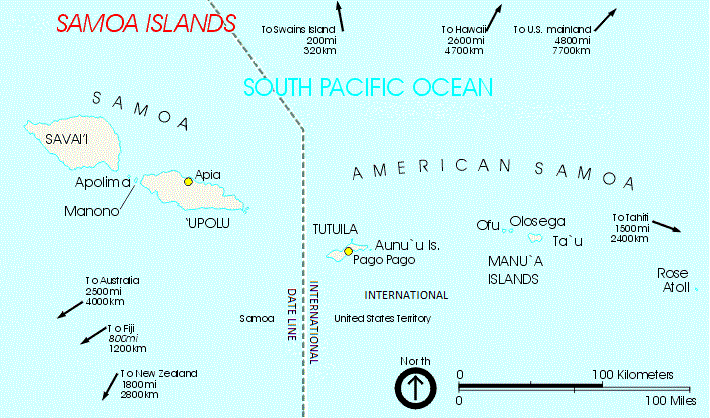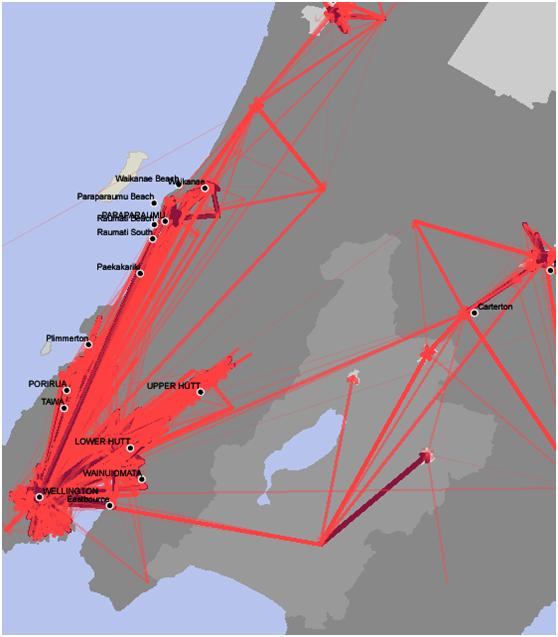|
Samoan Language
Samoan ( or , ) is a Polynesian languages, Polynesian language spoken by Samoans of the Samoan Islands. Administratively, the islands are split between the sovereign country of Samoa and the Unincorporated territories of the United States, United States territory of American Samoa. It is an official language, alongside English language, English, in both jurisdictions. It is widely spoken across the Pacific region, heavily so in New Zealand and in Australia and the United States. Among the Polynesian languages, Samoan is the most widely spoken by number of native speakers. Samoan is spoken by approximately 260,000 people in the archipelago and with many Samoans living in diaspora in a number of countries, the total number of speakers worldwide was estimated at 510,000 in 2015. It is the third-most widely spoken language in New Zealand, where 2.2% of the population, 101,900 people, were able to speak it as of 2018. The language is notable for the phonology, phonological differenc ... [...More Info...] [...Related Items...] OR: [Wikipedia] [Google] [Baidu] |
Samoan Islands
The Samoan Islands () are an archipelago covering in the central Pacific Ocean, South Pacific, forming part of Polynesia and of the wider region of Oceania. Political geography, Administratively, the archipelago comprises all of the Samoa, Independent State of Samoa and most of American Samoa (apart from Swains Island, which is geographically part of the Tokelau Islands). The land masses of the two Samoan jurisdictions are separated by of ocean at their closest points. The population of the Samoan Islands is approximately 250,000. The inhabitants have in common the Samoan language, a culture known as ''fa'a Samoa,'' and an indigenous form of governance called ''fa'amatai''. Samoans are one of the largest Polynesians, Polynesian populations in the world, and most are of exclusively Samoan ancestry. The oldest known evidence of human activity in the Samoan Islands dates to around 1050 BCE. It comes from a Lapita site at Mulifanua wharf on Upolu island. In 1768, the eastern island ... [...More Info...] [...Related Items...] OR: [Wikipedia] [Google] [Baidu] |
Official Language
An official language is defined by the Cambridge English Dictionary as, "the language or one of the languages that is accepted by a country's government, is taught in schools, used in the courts of law, etc." Depending on the decree, establishment of an official language might also place restrictions on the use of other languages. Designated rights of an official language can be created in written form or by historic usage. An official language is recognized by 178 countries, of which 101 recognize more than one. The government of Italy made Italian language, Italian their official language in 1999, and some nations (such as Mexico and Australia) have never declared ''de jure'' official languages at the national level. Other nations have declared non-indigenous official languages. Many of the world's constitutions mention one or more official or national languages. Some countries use the official language designation to empower indigenous groups by giving them access to the gover ... [...More Info...] [...Related Items...] OR: [Wikipedia] [Google] [Baidu] |
Atua
Atua are the gods and spirits of the Polynesian people such as the Māori or the Hawaiians (see also ). The literal meaning of the Polynesian word is "power" or "strength" and so the concept is similar to that of '' mana''. Many of the atua that are known have originated from myths and legends of each Polynesian culture before Christianity was introduced. These days, the word atua is related to the monotheistic conception of God. However for Polynesian cultures, as opposed to having only one superior god, there are multiple atua. For Māori, there are eight main atua – excluding the parents, Ranginui (sky father) and Papatūānuku (earth mother): * '' Tāne Mahuta'' – god of the forest and all forest creatures such as animals, birds and trees; * Tāwhirimātea – god of wind and storms; * Haumia-tiketike – god of uncultivated food and fernroot (also known as Haumia, Haumia-tikitiki, and Haumia-roa); * '' Rongo-mā-Tāne'' – god of Agriculture and Peace (a ... [...More Info...] [...Related Items...] OR: [Wikipedia] [Google] [Baidu] |
Aliʻi
The aliʻi were the traditional nobility of the Hawaiian islands. They were part of a hereditary line of rulers, the ''noho aliʻi''. Cognates of the word ''aliʻi'' have a similar meaning in other Polynesian languages; in Māori it is pronounced " ariki" and in Tahitian ari'i. Background In ancient Hawaiian society, the ''aliʻi'' were hereditary nobles (a social class or caste). The ''aliʻi'' consisted of the higher and lesser chiefs of the various levels on the islands. The ''noho aliʻi'' were the ruling chiefs. The ''aliʻi'' were believed to be descended from the deities. There were eleven classes of ''aliʻi'', of both men and women. These included the '' kahuna'' (priestesses and priests, experts, craftsmen, and canoe makers) as part of four professions practiced by the nobility. Each island had its own aliʻi nui, who governed their individual systems. ''Aliʻi'' continued to play a role in the governance of the Hawaiian islands until 1893, when Queen Liliʻuoka ... [...More Info...] [...Related Items...] OR: [Wikipedia] [Google] [Baidu] |
Cognate
In historical linguistics, cognates or lexical cognates are sets of words that have been inherited in direct descent from an etymological ancestor in a common parent language. Because language change can have radical effects on both the sound and the meaning of a word, cognates may not be obvious, and it often takes rigorous study of historical sources and the application of the comparative method to establish whether lexemes are cognate. Cognates are distinguished from loanwords, where a word has been borrowed from another language. Name The English term ''cognate'' derives from Latin , meaning "blood relative". Examples An example of cognates from the same Indo-European root are: ''night'' ( English), ''Nacht'' ( German), ''nacht'' ( Dutch, Frisian), ''nag'' (Afrikaans), ''Naach'' ( Colognian), ''natt'' ( Swedish, Norwegian), ''nat'' ( Danish), ''nátt'' ( Faroese), ''nótt'' ( Icelandic), ''noc'' ( Czech, Slovak, Polish), ночь, ''noch'' ( Russian), но� ... [...More Info...] [...Related Items...] OR: [Wikipedia] [Google] [Baidu] |
Austronesian Languages
The Austronesian languages ( ) are a language family widely spoken throughout Maritime Southeast Asia, parts of Mainland Southeast Asia, Madagascar, the islands of the Pacific Ocean and Taiwan (by Taiwanese indigenous peoples). They are spoken by about 328 million people (4.4% of the world population). This makes it the fifth-largest language family by number of speakers. Major Austronesian languages include Malay (around 250–270 million in Indonesia alone in its own literary standard named " Indonesian"), Javanese, Sundanese, Tagalog (standardized as Filipino), Malagasy and Cebuano. According to some estimates, the family contains 1,257 languages, which is the second most of any language family. In 1706, the Dutch scholar Adriaan Reland first observed similarities between the languages spoken in the Malay Archipelago and by peoples on islands in the Pacific Ocean. In the 19th century, researchers (e.g. Wilhelm von Humboldt, Herman van der Tuuk) started to apply the ... [...More Info...] [...Related Items...] OR: [Wikipedia] [Google] [Baidu] |
Isolating Language
Social isolation, Isolation is the near or complete lack of social contact by an individual. Isolation or isolated may also refer to: Sociology and psychology *Social isolation *Isolation (psychology), a defense mechanism in psychoanalytic theory *Emotional isolation, a feeling of isolation despite a functioning social network *Isolation effect, a psychological effect of distinctive items more easily remembered Mathematics * Real-root isolation * Isolation lemma, a technique used to reduce the number of solutions to a computational problem. * Isolated point, a topological notion of having no points near a given point Natural sciences *Electrical or galvanic isolation, isolating functional sections of electrical systems to prevent current flowing between them *An isolated system, a system without any external exchange *Isolating language, a type of language with a low morpheme-per-word ratio *Isolation (microbiology), techniques to separate microbes from a sample containing mixt ... [...More Info...] [...Related Items...] OR: [Wikipedia] [Google] [Baidu] |
Analytic Language
An analytic language is a type of natural language in which a series of root/stem words is accompanied by prepositions, postpositions, particles and modifiers, using affixes very rarely. This is opposed to synthetic languages, which synthesize many concepts into a single word, using affixes regularly. Syntactic roles are assigned to words primarily by word order. For example, by changing the individual words in the Latin phrase "''fēl-is pisc-em cēpit''" ("the cat caught the fish") to "''fēl-em pisc-is cēpit''" ("the fish caught the cat"), the fish becomes the subject, while the cat becomes the object. This transformation is not possible in an analytic language without altering the word order. Typically, analytic languages have a low morpheme-per-word ratio, especially with respect to inflectional morphemes. No natural language, however, is purely analytic or purely synthetic. Background The term ''analytic'' is commonly used in a relative rather than an absolute s ... [...More Info...] [...Related Items...] OR: [Wikipedia] [Google] [Baidu] |
Phonology
Phonology (formerly also phonemics or phonematics: "phonemics ''n.'' [''obsolescent''] 1. Any procedure for identifying the phonemes of a language from a corpus of data. 2. (formerly also phonematics) A former synonym for phonology, often preferred by the American Structuralists and reflecting the importance in structuralist work of phonemics in sense 1.": "phonematics ''n.'' 1. [''obsolete''] An old synonym for phonemics (sense 2).") is the branch of linguistics that studies how languages systematically organize their phonemes or, for sign languages, their constituent parts of signs. The term can also refer specifically to the sound or sign system of a particular language variety. At one time, the study of phonology related only to the study of the systems of phonemes in spoken languages, but now it may relate to any Linguistic description, linguistic analysis either: Sign languages have a phonological system equivalent to the system of sounds in spoken languages. The buil ... [...More Info...] [...Related Items...] OR: [Wikipedia] [Google] [Baidu] |
Statistics New Zealand
Statistics New Zealand (), branded as Stats NZ, is the public service department of New Zealand charged with the collection of statistics related to the economy, population and society of New Zealand. To this end, Stats NZ produces New Zealand census, censuses and surveys. Organisation The organisation's staff includes statisticians, mathematicians, computer science specialists, accountants, economists, demographers, sociologists, geographers, social psychologists, and marketers. Stats NZ is divided into seven organisational subgroups, each managed by a Deputy Government Statistician: * Macro-economic and Environment Statistics studies prices, and national accounts, develops macro-economic statistics, does government and international accounts, and Australian and New Zealand Standard Industrial Classification, ANZSIC 06 implementation (facilitating changeover to new classification code developed jointly with Australian statistics officials.) * Social and Population Statistics st ... [...More Info...] [...Related Items...] OR: [Wikipedia] [Google] [Baidu] |
United States
The United States of America (USA), also known as the United States (U.S.) or America, is a country primarily located in North America. It is a federal republic of 50 U.S. state, states and a federal capital district, Washington, D.C. The 48 contiguous states border Canada to the north and Mexico to the south, with the semi-exclave of Alaska in the northwest and the archipelago of Hawaii in the Pacific Ocean. The United States asserts sovereignty over five Territories of the United States, major island territories and United States Minor Outlying Islands, various uninhabited islands in Oceania and the Caribbean. It is a megadiverse country, with the world's List of countries and dependencies by area, third-largest land area and List of countries and dependencies by population, third-largest population, exceeding 340 million. Its three Metropolitan statistical areas by population, largest metropolitan areas are New York metropolitan area, New York, Greater Los Angeles, Los Angel ... [...More Info...] [...Related Items...] OR: [Wikipedia] [Google] [Baidu] |





